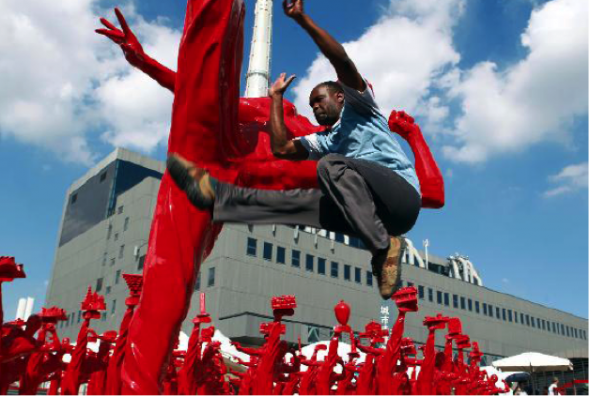When I was young, I watched Wang Yu and Bruce Lee’s movies.
People were flying in the air, so I thought:
Chinese people are the best. They know how to fly!
I’ll go to China to fly.
Captivated by the kung-fu masters in the movies, a young Gabonese sets off for China to learn the sacred art. Years later, in 1985, he becomes the Shaolin Temple’s very first Black master. Dancing between Beijing and Libreville, French and Chinese, present interviews and old archival footage L’Africain Qui Voulait Voler/The African Who Wanted to Fly (Samatha Biffot, 2016) tells the unlikely story of Luc Benza.
Biffot’s biography of Benza blends together many different kinds of material, places and languages into a mesmerizing mosaic. The film adroitly shifts between Gabon; where close friends share their memories of Benza through interviews; and old home videos show a young Benza imitating his favourite fight sequences from films, and China; with extracts from the very movies that captured his young imagination; clips from his early competition days as a wushu student; and present-day life scenes with his family in Beijing.

The film often underscores shots from Gabon with traditional Chinese instruments, thus music serves as one of the strands that knits these places together. In other instances, images from the two countries are superimposed, bringing the two worlds even closer together as we fade out from a scene in Beijing, into another from Libreville. None of these transitions call attention to themselves, instead their seamlessness allows the viewer to be fully immersed into all the different chapters in which Benza pursues this unlikely dream.
In chronicling this journey to martial arts mastery, The African Who Wanted to Fly explores the racial and cultural discrimination that Benza faced. In his interviews, he recounts some of the opposition that was raised against him, including apprehension about a foreigner being allowed to learn wushu. This story is most poignant in a moment where he remembers his coach, Lin Boyuan. With a grimace, Benza hints that the backlash, against the secrets of this traditional Chinese art being taught to a black man, may be the reason why Boyuan no longer lives in China. In a matter of seconds, the change in Benza’s demeanor from his usual laughing jovial self, to a man who speaks in few words and with a pained expression on his face, conveys the extent to which these memories still haunt him.

Even after he establishes himself, he continues to face some obstacles when he becomes an instructor at the Beijing Sports University. Benza recounts parents who question why he, a foreigner, is being permitted to give lessons to young Chinese children about something that is such a profound aspect of their own national tradition. The inclusion of such obstacles provides sobering moments that enrichen the largely triumphant story of Benza’s successful quest to become the first Black wushu master.
These critical moments could have been pushed further. Unfortunately, in crafting its hopeful ending, Biffot’s documentary stunts its discussions of discrimination to the past, giving no indication of what the contemporary attitudes towards Africans in China are. The African Who Wanted to Fly opens in a field full of African trainees, admirers of Benza who have also made the trip to the Shaolin Temple to become wushu masters. And, towards the end, it reveals that Benza has opened his own academy in Libreville to raise up future Gabonese wushu artists. Yet despite giving face to the present and future African martial arts practitioners, the film gives no indication of whether they will face the same prejudices that Benza did, or how attitudes towards black martial artists have since changed.

At a moment where most China-Africa coverage centers on ecopolitics, The African Who Wanted to Fly, with its light-hearted story about a young boy and his dream, is a welcome change in the way we think about our continent’s relationship with China. It is fascinating to witness this Sino-African connection, precisely because it is one that preceded the current model of largely one-sided aid and investment. A love affair with China, built on something a lot more wondrous than trade and loans: art.
On many levels, this is a film about cinema itself as an engine of dreams. In its final scene, Benza and two of his friends, continue to evoke childhood memories in a screening room, in which old archival footage of them as children, practicing their newly learnt kung fu moves, is projected. In this way, through this very personal tale, The African Who Wanted to Fly offers a snippet into early cinema trends in West Africa. As Benza and his friends reminisce about the countless kung-fu films they watched in cinemas, we are given an indication of the popularity of Chinese movies back in the 1980s.

Given the analogous popularity of Latin American telenovelas and Bollywood soap operas on television today, it almost makes you wonder what dreams are being spurred on by this new programming and how and where the story of the next Benza will unfold?
—
Written by Nnenna Onuoha


1 Comment